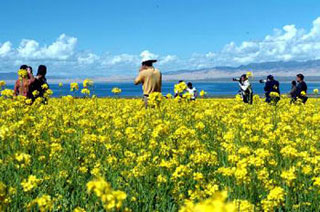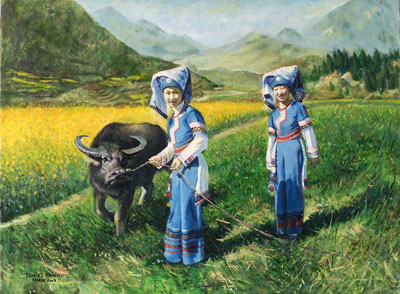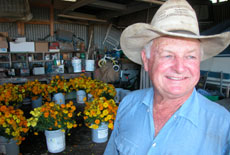Human Flower Project
Chinas Oil Seed And Oil Seed Painter
By on February 28th, 2022 in
Friday, November 17, 2006
China’s Oil Seed and Oil Seed Painter
A major exporter of rapeseed, China has developed new oil rich strains, and an artist discovers its “Yellow Magic” around the globe.

Tourists photograph a field of rape
near Qinghai Lake, China, August 2006
Photo: People’s Daily
What’s more versatile than egg yolk, and just as yellow?
Brassica napus Linnaeus, or rapeseed, a mustard relative with the color to prove it. When it blooms around China’s Qinghai Lake, the tourists and the bees are out in force.
Richard Restell’s piece in That’s Beijing describes the buzz and bustle in western China when the rapeseed fields flower. “In the doorway an elderly lady is busy removing royal jelly from the cells of a comb, while several yards away Zhang Chen busily inspects the hives, removing the trays one by one and glancing over them with a professional eye. ‘I have been coming here for ten years and each year business improves,’ he says, ‘but competition is increasing and the lakeshore area is becoming quite crowded.’ Glancing along the highway it is clear that Zhang is right, the hives of other beekeepers are discernable in the distance, row upon row of industrious activity, the sky a multitude of little zipping black dots above a sea of yellow.”
Rapeseed isn’t widely cultivated in the U.S., but neighbor Canada grows about 4 million acres. The pressed oil makes an ingredient of margarine and shortening, and “rape produces nectar sufficiently to be considered a better honey plant than white or red clover (Hammer 1966). The nectar can be seen glistening in the bottom of the flower all day, and a colony of honey bees may store 15 to 33 pounds of honey per day (Palmer 1959). ” The plant has fed livestock for many centuries, too.
China, India, Canada and Europe are the world’s biggest producers, with China stretching its lead. In September, the Ministry of Agriculture announced its ag scientists had developed a new strain of rapeseed with the highest oil content ever: 54.72%. This comes as welcome news for the biodiesel business and its supporters. Next year’s International Rapeseed Congress, the 12th such gathering, will take place in Wuhan, China, March 26-30. Sounds like prime flower time.
 “Yellow Palace”: Jiulongpu, Quijing
“Yellow Palace”: Jiulongpu, Quijing
Painting: Daniel Chieh
A very different kind of Human Flower Project involving rapeseed is the work of Daniel Chieh, who traveled to ten countries painting rapeseed in bloom. Chieh has found and captured the yellow fields in the U.S. (Arkansas), Ireland, Canada and throughout China, including Qinghai. Chieh was once a big omlet of high-tech industry but gave it up to travel and pursue his art.
“What is success?” he—like Allen Toussaint—asks. “When I’m young, I always think that success is being rich, owning a large house, having a stable job and so on. However, after experiencing hardships, now I have begun to realize that success is a kind of proficiency, a kind of capacity to grasp the good in the ordinary things of life, the imperceptible, and the capacity to feel appreciation.”
After his “yellow” year painting rapeseed (2002-2003), Chieh went on to investigate white (cranes), black-green (rivers) and purple-blue (the sky). In 2007, he’ll explore red (old towns). Daniel, may we recommend Smithville, Texas, preferably in April: no rapeseed here that we know of but lots of sweet old red brick buildings on Main St. and, if we’re all lucky, bluebonnets, Indian paintbrush, primrose, winecups, and prickly poppy all around the edges of town.




